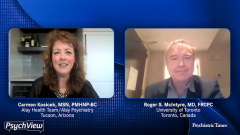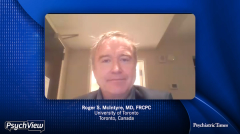
Communicating With Patients About MDD Treatment
Roger S. McIntyre, MD, FRCPC; and Carmen Kosicek, MSN, PMHNP-BC, discuss provider and patient communication about the time to onset of action of major depressive disorder (MDD) treatments and when the patient can expect to see a difference.
Episodes in this series

Roger S. McIntyre, MD, FRCPC: My own sort of reaction to that, Carmen, is that…one of the struggles I’ve had clinically with the usual antidepressant approaches is that the patients suffering from major depression, they have terrible symptoms, fatigue, lack of interest, lack of motivation. And I think we all know psychiatric medications in general don’t enjoy a surplus of good public relations. In other words, people have a lot of concerns about going on medications. Some of these concerns are entirely valid. Some need to be, I think, addressed head-on with psychoeducation. There’s a lot of misinformation about our medications. But where I’m going with this is that we often ask patients to say, “Hey, look, the medication won’t work really in a way that’s meaningful for you for 4 to 6 weeks, but just put up with all these [adverse] effects,” and that’s obviously a very difficult calculation. That’s another reason why we want rapid resolution. Of course, we want human suffering to stop. But I think it also very much changes the calculus in the sense that I think people are more likely to consider [continuing] those treatments if they see benefit sooner or later.
Carmen Kosicek, MSN, PMHNP-BC: One hundred percent. You know, it’s really important also, as you’re saying, to outline the vision of hope for the patient with when…the onset of action [would] be for the medications and when could they feel this. With the current medications that are on the market, I would encourage prescribing providers to actually share the screen, whether they’re seeing patients [via telehealth] or in person, of the health care professional site of those medications where the clinical trial data is outlined, which shows the primary end points and how fast separation is from placebo. Not only does that help the provider, to continuously have the FDA-approved data in front of them, but it showcases to the patient that there really is hope, that hundreds of people have already done this in their clinical trials, or if the sample size is 100 or whatever it is, along with the 1 year of additional trial data that is now on with most medications. From there, once a provider is using these newer meds that are on the market, not everyone will respond to that specific medication, no differently than they have in the past. And that’s where it’s imperative for all of us to realize what is in the pipeline and how close we [are] to the next medication that’s ready to be out there. So, for example, the reason that I do this is to showcase to the patient, “Hey, if this one is not the one for you, here’s what we have, and it’s right around the corner.” To be more specific, utilizing the medications that are currently on the shelf. I do that all day, every day. By the time they make it to me, the last thing that they need is yet another SSRI [selective serotonin reuptake inhibitor] or an SSRI NRI [norepinephrine reuptake inhibitor], or the polypharmacy that they come with. It’s a lot of [medication], and patients are not wanting that. They want [a] streamlined approach of medications and fast relief of symptoms. The dextromethorphan-bupropion combination is [a] fantastic choice for right now for patients. But in addition to that, I am already making notes in my charts for the next medication that’s coming out that almost is dosed like some of the antibiotics that we’ve used in the past. Just a very short duration.
Transcript is AI-generated and edited for clarity and readability.
Newsletter
Receive trusted psychiatric news, expert analysis, and clinical insights — subscribe today to support your practice and your patients.



















